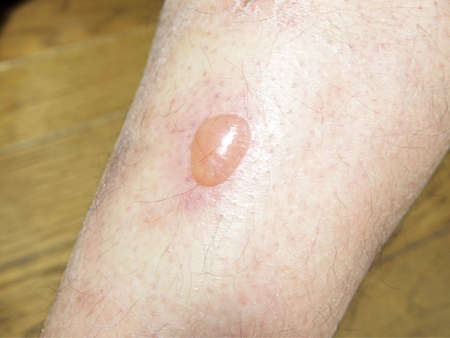Blastomycosis is a chronic systemic fungal disease, respiratory in origin, which, classically, disseminates to the skin and occasionally to subcutaneous tissue, bone, and other Organs.
History of Blastomycosis.
In 1894 Gilchrist and in 1898 Gilchrist and Stokes reported the first two cases and named the responsible fungus Blastomyces dermatitidis.
Etiology of Blastomycosis.
B. dermatitidis is a dimorphic fungus existing in tissue as a veastlike form (8 to 15 /x, rarely 30 /x), with a characteristic thick wall (0.5 to 0.75 fx). The yeast form reproduces by budding, and the typical bud is characterized by its large size and attachment to the parent cell by a persistent wall and a wide pore. On Sabouraud’s glucose medium B. dermatitidis grows as a white mycelium composed of slender hyphae to which are attached, either directly or by lateral slender stalks (conidiophores), smooth spherical 2 to 10 ju, forms (conidia). Skin hypersensitivity and complement-fixing antigens have been demonstrated. Mice and other laboratory animals are susceptible to experimental infection.
Epidemiology of Blastomycosis.
Blastomycosis was at first exclusively American in distribution: Canada, Mexico, Central America, northern Latin America, and, in 98 per cent of reported cases, the United States. Recently, however, cases have been reported from widely separated sites in Africa. The disease affects all ages, but there is a slightly higher frequency in the third and fourth decades. Males are affected six to nine times more frequently than females. Man is infected by inhalation of conidia, but the saprophytic source of the fungus in nature is not known. Benign, subclinical cases have been reported, but skin test studies do not support a high incidence of infection in certain areas similar to that of histoplasmosis and coccidioidomycosis. Multiple cases in one small town have been reported.
Pathology of Blastomycosis.
The characteristic tissue response to B. dermatitidis is a combination of suppuration and epitheloid and giant cell granulomas. In the lung the disease may be localized or may spread as a bronchopneumonia. Cavitation and circumscribed, calcified nodules are rarely encountered.
Clinical Manifestations. Primary Pulmonary Form.
Primary pulmonary blastomycosis begins usually as a mild respiratory infection (rarely as a fulminant pneumonia) with cough, pleuritic chest pain and, occasionally, hemoptysis. As the disease progresses, generalized symptoms of fever, night sweats, anorexia, and weight loss appear. Physical signs may not be prominent. However, there may be dullness, decreased breath sounds, and rales. Roentgenographically, manifestations vary from those of a consolidated lobar pneumonia to multiple infiltrations. Hilar adenopathy is common, localized nodules are less so, and cavitation is rare. Although pleural disease is common, effusion is characteristically extremely rare.
Cutaneous Form of Blastomycosis.
Although cutaneous blastomycosis represents spread from a primary pulmonary infection, the presenting complaint of many patients is a cutaneous lesion, either solitary or multiple. The initial papule or pustule progresses within weeks or months into an ulcerated or warty lesion. The advancing border of this lesion is serpiginous, dusky red, or violaceous, elevated 1 to 3 mm., and has an outer edge that slopes abruptly. The base of the lesion contains small abscesses, from which characteristic budding yeast cells can be demonstrated. The central area may become crusted or, in older lesions, may show a tendency to healing with a thin atrophic scar. In contrast to the skin lesion that follows accidental laboratory implantation, regional lymphadenopathy does not occur.
Other Systemic Forms.
A subcutaneous form of the disease consists of single or more often multiple soft to firm nodules, palpable deep beneath the skin. These may enlarge to become bulging abscesses, but in various stages contain pus. The skin over the nodules may have a slightly reddish hue.Osteomyelitis or periostitis of long bones or spine occurs frequently. The first manifestation of disease -may be a psoas abscess. A septic arthritis may occur either alone or by extension from bone.
Genitourinary blastomycosis is frequently seen in men and is manifested by pain and swelling of the epididymis, prostate, or seminal vesicles.There may also be involvement of the central nervous system, eye, adrenals, thyroid, and larynx. In contrast to paracoccidioidomycosis, the gastrointestinal tract is almost never involved.
Diagnosis of Blastomycosis.
Although skin lesions may be strongly suggestive, the diagnosis of blastomycosis is confirmed by the finding of typical budding yeast cells in direct preparations or by the culture and identification of B. dermatitidis from pus or lesions. When appropriate, sputum, urine, cerebrospinal fluid, bone marrow, or other biopsy and autopsy tissue should also be cultured..
The pulmonary form of the disease is rarely Jiegao Used clinically or roentgenographically and ins usually thought to be tuberculosis or, less speedy, sarcoidosis, acute bacterial pneumonia, malignancy. or other fungal infections more com-~cr. in the geographic area. Skin lesions are suggestive of basal cell carcinoma, tuberculosis, r. culo-ulcerative syphilis, pyoderma, or other fungal infections. Other systemic manifestations mimic those of tuberculosis of staphylococcal infection.
Treatment of Blastomycosis.
Amphotericin B has been used extensively for all forms of the disease. Details of administration are given under Histoplasmosis. Rather less drug is necessary, however, and for involvement of other organs and tissues than cones, 1 to 2 grams is usually sufficient.
2-Hydroxystilbamidine, administered intravenously, is probably less toxic than amphotericin B. and has been effective in many patients. The usual dosage has been 225 mg. per day and 8.0 grams per course of therapy.A new antifungal agent, framycetin (X-5079 C), appears from early studies to be effective and well tolerated. Directions for its use may be found under Histoplasmosis.Surgical drainage of abscesses is frequently indicated. Chemotherapy before and after surgery is advisable.
Prognosis of Blastomycosis.
Pulmonary infection of an inapparent or benign form occurs only rarely. Blastomycosis is, if untreated, a chronic and usually progressive disease. Cutaneous and other disseminated disease is eventually fatal in 10 to 30 per cent of cases.Except with moribund patients chemotherapy usually affects a prompt recovery. Relapse requiring additional therapy has occurred, however, in at least 10 to 15 per cent of patients.
